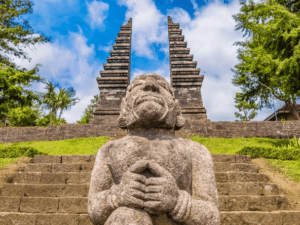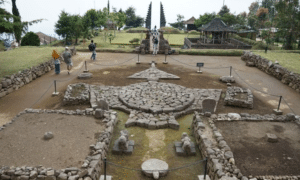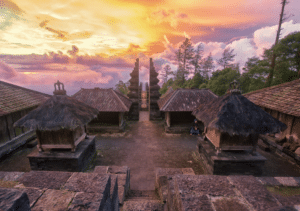Nestled on the slopes of Mount Lawu in Central Java, Indonesia, Cetho Temple stands as a testament to the grandeur of the late Majapahit Empire. This Hindu temple complex, dating back to the 15th century, is not only an architectural marvel but also a place of deep spiritual significance. For travelers and history enthusiasts alike, a visit to Cetho Temple promises a unique blend of cultural immersion and serene natural beauty.
Historical Significance
Cetho Temple, or “Candi Cetho” in Indonesian, was constructed during the reign of the Majapahit Kingdom, one of the last major Hindu empires in Indonesia. This period was marked by a renaissance in art, culture, and religious architecture. The temple’s construction was initiated to purify the surrounding area from negative energy following a devastating plague.
The temple complex is composed of multiple terraces ascending the hillside, each adorned with intricate carvings and statues depicting scenes from Hindu mythology. The higher terraces are believed to represent the higher spiritual planes, culminating in the main sanctum, which is dedicated to Shiva, one of the principal deities in Hinduism.
Architectural Marvel
Cetho Temple’s architecture is a striking example of Javanese-Hindu design. The complex is divided into fourteen terraces, each representing a stage of spiritual ascent. Visitors are greeted by a large gate at the entrance, adorned with carvings of mythological figures and protective deities.
As you ascend, you will encounter numerous statues and reliefs, including the prominent Lingga and Yoni symbols, representing Shiva and his consort Parvati. These symbols signify fertility and creation, central themes in Hindu philosophy. The main sanctum, located on the highest terrace, is a modest but intricately designed structure where rituals and offerings are still conducted by local devotees.
Spiritual and Cultural Experience
Cetho Temple is not just a relic of the past; it is a living place of worship. The local Javanese Hindu community continues to perform religious ceremonies here, especially during significant Hindu festivals. This ongoing tradition offers visitors a rare opportunity to witness and participate in ancient spiritual practices.
The temple’s serene environment, surrounded by lush tea plantations and panoramic views of the mountainous landscape, provides a tranquil setting for meditation and reflection. The journey to Cetho Temple is also an adventure in itself, with winding roads through dense forests and picturesque villages that showcase the natural beauty of Central Java.
Practical Information for Visitors
Cetho Temple is located approximately 45 kilometers from Solo (Surakarta) and can be reached by car or motorcycle. The best time to visit is during the dry season, from May to October, when the weather is most favorable for travel and exploration.
Visitors are advised to dress modestly and respectfully, as Cetho Temple remains a place of active worship. Comfortable footwear is recommended due to the uneven terrain and numerous steps leading up to the temple complex.
Experience Indonesia with DoorToID
If you’re a foreign traveler planning to explore the rich cultural heritage of Indonesia, DoorToID is here to assist you. We specialize in facilitating entry permits, stay permits, and working permits for foreigners. Our user-friendly mobile apps, available on both Apple and Android platforms, make the application process seamless and efficient.
For any inquiries or further information, please contact us at [email protected] or visit our submission portal at https://apps.doortoid.com. Let DoorToID help you unlock the wonders of Indonesia with ease and convenience.
Embark on your journey to Cetho Temple and experience the timeless allure of Indonesia’s cultural and spiritual heritage. With DoorToID, your adventure awaits!




